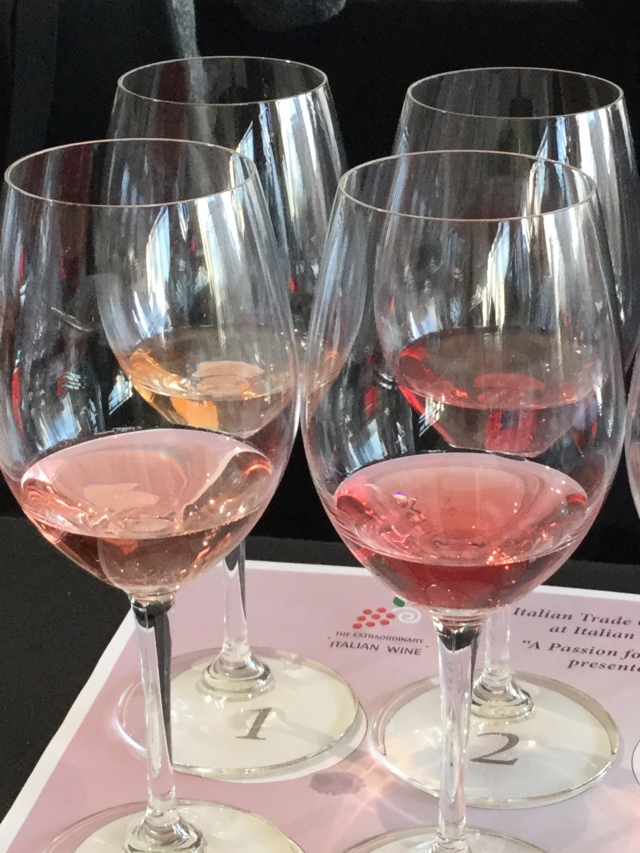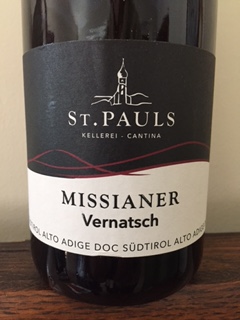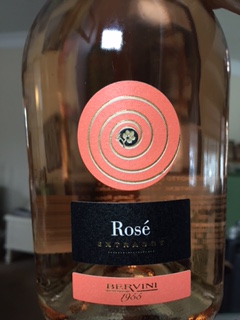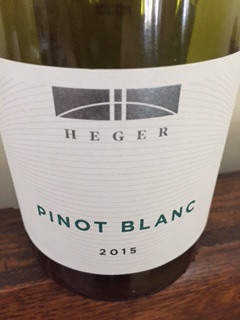If it’s snowing outside your window, join the club – but tonight, instead of warming up with a glass of BigSexyRed, I’m switching gears and pouring some refreshing rosé. It’s light and floral, the low alcohol level won’t make me drowsy, and the sunshine-rosy-pink tone tells me spring is right around the corner. (It is, right?)
But don’t look at your rosé through rose-colored glasses. Go to a tasting and you’ll see what I mean: not all rosé is a deep pink, or salmon, or whatever color you’re expecting. I took this photo at a tasting recently, and some of the rosés could easily have passed for a Chardonnay or, at the other end of the rosé palette, a Pinot Noir:

That makes sense if you know how winemakers make rosé pink: the color comes from the grape skins. The intensity of the color is the winemaker’s choice: for darker wine, the grapes are gently crushed and the juice sits with the skins, macerating, for three days or more. For a pale wine, the winemaker might drain off the juice after just a few hours, at which point the juice (“must”) will ferment in a separate vat, away from the skins.
If you see the words “carbonic maceration” on the label, that means there is no deliberate crushing of the grapes to extract the juice. The winemaker simply loads whole clusters of grapes into a vat and the weight of the grapes on top slowly crushes those below. Instead of adding yeast to start converting the sugar into alcohol, the grapes themselves produce enzymes that function just as yeast would – they start converting sugar into alcohol. Winemakers in the French village of Tavel use this method to make the rosé that made the region famous.
Some rosé producers take a shortcut: they simply blend finished white wine with a finished red until the wine is exactly the color and taste they prefer. It sounds like cheating, but some respected French producers use this approach.
The delectable result is a delicate, fruity wine with enough acidity to make it crisp and lively in your mouth. The Guardian in the U.K. calls it, “the booze of choice for millennials.” If your rosé was produced in Europe, chances are it’s on the drier side than if it were from, say, Australia.
Here’s why I’m writing about (and drinking) rosé: yesterday was Beaujolais Nouveau Day, the day winemakers in the French region of Beaujolais traditionally release “the first wine of the harvest.” For the first time, producer Les Vins Georges Duboeuf also released a Beaujolais Nouveau Rosé. Like their Beaujolais Nouveau 2018 (and every vintage), the rosé is made with 100 percent Gamay grapes.
I cracked my bottle and will buy more for Thanksgiving. Beaujolais Nouveau, as you know, doesn’t age well, so we’ll drink it next week. You should be able to find the rosé, reviewed below, at wine shops and supermarkets in time for the holiday. And be sure to read the label – don’t buy a “blush” wine or White Zinfandel unless you like to pair cotton candy with your turkey.
Wine Lingo: Rosado = in France, the clear, pink color of rosé. Italians use a similar term: rosato.

[This bottle of Beaujolais Nouveau Rosé was sent to BigSexyReds for review.]
Vino ‘View: Georges Duboeuf Beaujolais Nouveau Rosé 2018 (12.5 percent alcohol, $13.99). This affordable, hand-harvested, lipstick-pink wine is as vibrant as the label design implies, and it’s fruit-forward all the way. Stone fruit and strawberry aromas hit you first, quieting down to soft, tangy red raspberries on the palate with a touch of lime. Expect strong acidity. This light wine will pair nicely with your turkey, even better with pumpkin pie. It’s a safe bet with the slight sweetness of jellied cranberry sauce, too.
Cheers!
Mary





















